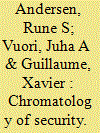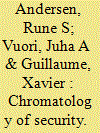| Srl | Item |
| 1 |
ID:
141461


|
|
|
|
|
| Summary/Abstract |
The agenda of this article is to highlight how security becomes intelligible, is enacted, contested and (re)appropriated in part through colour use. Even though colours are a natural phenomenon, their meanings are societal products, and part of our constructed visibilities. These can be investigated through chromatology, the study of colour in relation to people. We illustrate this by applying multimodal social semiotics to view highly securitized sites, those of concentration and enemy-combatant camps. We show that the colour uses instituted to classify and govern prisoners not only structure the inmates socially, but also become vehicles for resisting the security discourses associated with them. The aim of the article is to highlight how security and international relations are intersemiotic relations, and to open up the study of security to an expanded range of semiotic modalities and methods of inquiry.
|
|
|
|
|
|
|
|
|
|
|
|
|
|
|
|
| 2 |
ID:
141780


|
|
|
|
|
| Summary/Abstract |
The agenda of this article is to highlight how security becomes intelligible, is enacted, contested and (re)appropriated in part through colour use. Even though colours are a natural phenomenon, their meanings are societal products, and part of our constructed visibilities. These can be investigated through chromatology, the study of colour in relation to people. We illustrate this by applying multimodal social semiotics to view highly securitized sites, those of concentration and enemy-combatant camps. We show that the colour uses instituted to classify and govern prisoners not only structure the inmates socially, but also become vehicles for resisting the security discourses associated with them. The aim of the article is to highlight how security and international relations are intersemiotic relations, and to open up the study of security to an expanded range of semiotic modalities and methods of inquiry.
|
|
|
|
|
|
|
|
|
|
|
|
|
|
|
|